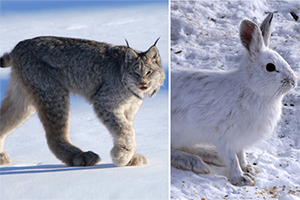

 This module introduces students to models used to predict populations of organisms within an ecosystem. Students will analyze a simple predator-prey system, optionally building and “running” a simple, spreadsheet based model. They will compare the population graphs produced by the model with actual historical data from a similar, simple predator-prey system. Then, students will collect data on “virtual dives” in simulated marine habitats. They will gather biomass data for predators and their prey in complex marine food webs and compare changes over time to the behaviors of the simpler systems with just a single predator and its lone prey.
This module introduces students to models used to predict populations of organisms within an ecosystem. Students will analyze a simple predator-prey system, optionally building and “running” a simple, spreadsheet based model. They will compare the population graphs produced by the model with actual historical data from a similar, simple predator-prey system. Then, students will collect data on “virtual dives” in simulated marine habitats. They will gather biomass data for predators and their prey in complex marine food webs and compare changes over time to the behaviors of the simpler systems with just a single predator and its lone prey.
The following are all the resources for implementing this module:
 Module Activities
Module Activities VES-V Virtual Dive Tutorial
VES-V Virtual Dive Tutorial Student Data Worksheets
Student Data Worksheets NGSS aligned to this module
NGSS aligned to this module Presentation Graphics Used in this Module
Presentation Graphics Used in this ModuleThe VES-V is visually driven in nature and supported by the third-party "perspectx.com." Color contrast, assistive technology support, and alternate text may be unsupported.
The following activities within the Predators and Prey Module may be completed without the use of VES-V software. As some of these were originally designed to be used with it, they will require some adaptation by the educator to make them accessible for students with disabilities.
We welcome your feedback. Please let us know if you encounter accessibility barriers on any of our education content: nos.info@noaa.gov
Social